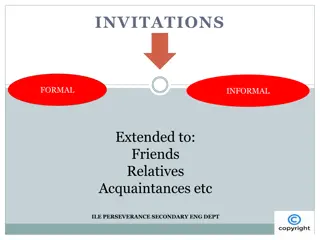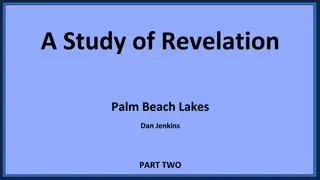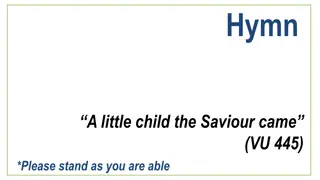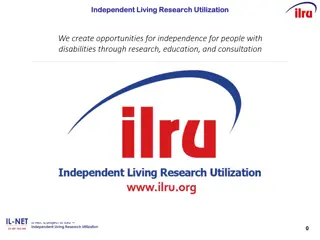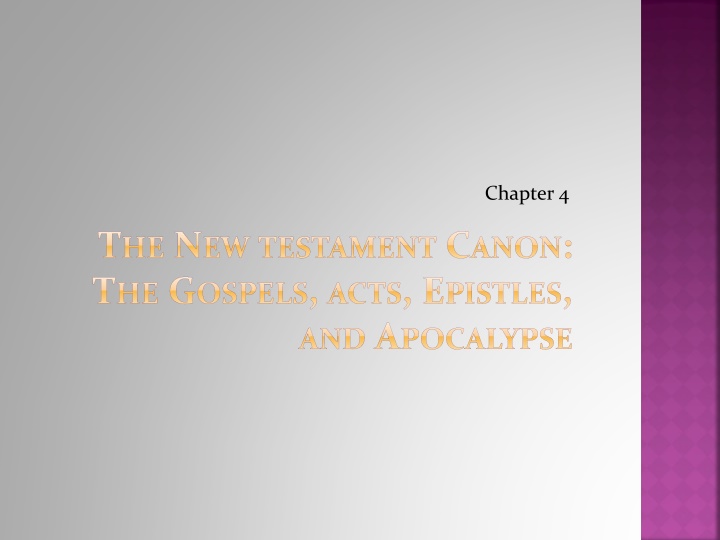
The New Testament Canon and Gospel Narratives
Delve into the formation of the New Testament Canon, focusing on the Gospels, Acts, Epistles, and Apocalypse. Explore how the Gospels narrate Jesus' life, Acts continues His mission through the early church, Epistles flesh out Christ's vision, and the Apocalypse brings the canon to a glorious conclusion. Discover the significance of the Gospels in presenting Jesus' sacrifice and message of the kingdom of God.
Uploaded on | 3 Views
Download Presentation

Please find below an Image/Link to download the presentation.
The content on the website is provided AS IS for your information and personal use only. It may not be sold, licensed, or shared on other websites without obtaining consent from the author. If you encounter any issues during the download, it is possible that the publisher has removed the file from their server.
You are allowed to download the files provided on this website for personal or commercial use, subject to the condition that they are used lawfully. All files are the property of their respective owners.
The content on the website is provided AS IS for your information and personal use only. It may not be sold, licensed, or shared on other websites without obtaining consent from the author.
E N D
Presentation Transcript
Chapter 4 THE NEW TESTAMENT CANON: THE GOSPELS, ACTS, EPISTLES, AND APOCALYPSE
CHAPTER OUTLINE New Testament Canon The Gospels and the Gospel The Book of Acts and the Early Church The Epistles, Christ, and the Churches The Apocalypse and the Revelation of the Word
THE NEW TESTAMENT CANON The Gospels narrate the life of Jesus of Nazareth, focused on his death and resurrection. The Book of Acts continues this narration by showing what Jesus continued to do in and through the mission of the early church (the implication of Acts 1:1). The Epistles are documents fleshing out the fulfillment of Christ s vision, On this rock I will build my church (or, perhaps more accurately, my messianic community ; Matt. 16:18). The Apocalypse brings the canon to a glorious exclamation point by focusing all eyes on the triumphant return of the Lamb of God-turned-Lion of Judah who judges the world and gathers the elect to be with him in heaven forever.
THE GOSPELS AND THE GOSPEL Matthew, Mark, Luke, and John root Jesus mission at the very outset in the Hebrew Scriptures (i.e. the Old Testament). The same is true for the first epistle and first letter by Paul in the New Testament canon, the Book of Romans. The Apocalypse, too, presents Christ in keeping with Old Testament characters and imagery (e.g., Rev. 1:17 3:22).
THE GOSPELS AND THE GOSPEL All four Gospels culminate in the Passion narrative, and all cohere and concur in presenting Jesus sacrifice as substitutionary and atoning. Thus the Gospels form the perfect backdrop for Paul s statement in 1 Corinthians: For what I received I passed on to you as of first importance: that Christ died for our sins according to the Scriptures, that he was buried, that he was raised on the third day according to the Scriptures (1 Cor. 15:3 4).
THE GOSPELS AND THE GOSPEL With regard to Jesus message, at least in the Synoptics, the theme that dominates is that of the kingdom of God. God s kingdom, in keeping with his promises to David (e.g., 2 Sam. 7:14), represents a fulfillment of Old Testament promises to Israel. Kingdom also conveys the notion of God s reign or rule over his people, and in Jesus, God s kingdom is already present (Luke 17:21). The Gospels provide us both with the complement to the Old Testament and constitute the foundation of the New Testament canon.
THE BOOK OF ACTS AND THE EARLY CHURCH Acts continues the narration of Jesus mission in the four Gospels (cf. John 21:25 and Acts 1:1). Thus in its canonical embeddedness and strategic placement, the Book of Acts registers the important claim that the life and mission of the early church is grounded in the life and mission of Jesus Christ himself.
THE BOOK OF ACTS AND THE EARLY CHURCH The most important ingredients of New Testament theology contributed on a canonical level by the Book of Acts are the following: (1) The mission of the church is conducted in the power of the Holy Spirit following his coming at Pentecost (Acts 2). (2) Acts marks a new kind of relationship sustained between believers and Jesus. (3) Acts is first and foremost about mission, God s irresistible, inexorable pursuit of lost sinners with the gospel of forgiveness and salvation in the Lord Jesus Christ, thus fulfilling the Old Testament promise of God s blessing extending to the nations. On a canonical level, Acts shows the mission of the early church to be grounded both in the Hebrew Scriptures and in Jesus mission.
THE EPISTLES, CHRIST, AND THE CHURCHES Acts as Essential Background to the Epistles Passage in Acts Background Letter 14; 16:6 Churches planted in Galatia Galatians 15 Jerusalem Council James 16:1 5 Paul and Timothy 1 2 Timothy 16:11 40 Church planted in Philippi Philippians 17:1 9 Church planted in Thessalonica 1 2 Thessalonians 18:1 17 Church planted in Corinth 1 2 Corinthians 19; 20:13 38 Church planted in Ephesus Ephesians 28:30 31 Paul preaches in Rome Prison Epistles
THE EPISTLES, CHRIST, AND THE CHURCHES With regard to a Pauline letter collection, there is some New Testament evidence that the Pauline corpus was formed very early, even while Paul s letters were still being written (2 Pet. 3:15 16). There is also good reason to believe that Paul wrote 13 epistles included in the New Testament canon: Galatians, 1 2 Thessalonians, 1 2 Corinthians, Romans, the Prison Epistles (Ephesians, Philippians, Colossians, and Philemon), and the Pastoral Epistles (1 2 Timothy, Titus).
THE EPISTLES, THE CHRIST, AND THE CHURCHES While the Book of Acts provides the foundation for our canonical reading of the New Testament Epistles, however, the latter go beyond a mere description of the progression of the mission of the early church. Each of the letters gives us an account of the problems and issues facing a particular church plus the New Testament writer s adjudication of these matters. Because of their apostolic nature, many of these adjudications should be expected to have permanent relevance, at least on a principial level (e.g., 1 Timothy 5:19 25). The New Testament Epistles also supply us with a more full-fledged theology of the implications of the work of Christ for the life of the believer.
THE EPISTLES, THE CHRIST, AND THE CHURCHES Thus, on a canonical level, the Epistles build on and yet go beyond the Gospels and the Book of Acts. In the Book of Acts, we read about Paul; in his Epistles, we hear from Paul directly. Conversely, in the Gospels, we hear from Jesus directly; in the Epistles, we hear about the ramifications of Jesus work for believers. Both are necessary and complementary. In the end, canonically speaking, the New Testament Epistles are a vital part of inspired Scripture and of authoritative divine revelation. Hermeneutically, while the Book of Acts, as a historical narrative, tells us more overtly what did take place in the early church, the Epistles, as didactic material, focus more explicitly on what should happen in the church, both by way of direct and case study or principle.
THE APOCALYPSE AND THE REVELATION OF THE WORD On a canonical level, the Apocalypse presents the consummation of the age and the fulfillment of God s plan for humanity and the cosmos in Christ. In continuity with the Epistles, the Book of Revelation, too, includes seven epistles to the seven churches of Asia Minor (Revelation 2 3), including Ephesus, to which also one of Paul s letters is addressed. The concluding warning against adding to or taking away any words from the prophecy of the book extends at least to the Book of Revelation in its entirety and very likely on a canonical level to the entire canon of Scripture. On a salvation-historical as well as on a literary and theological level, the Apocalypse thus provides a satisfying conclusion to the New Testament and biblical canon.
GUIDELINES Assign the passage you are studying to one of the following: Gospels/Acts, Epistles, Revelation. Understand the salvation-historical location of the book you are studying: in the Gospels, the earthly ministry of Jesus; in the Book of Acts and the Epistles, the church age and the mission of the early church; in Revelation, the end times. Be careful to observe how each of the respective portions of the New Testament canon complement and supplement one another and interpret them in proper relation to each other. For example, when studying Philippians, consult the account of the planting of the church of Philippi in the Book of Acts. 1. 2. 3.
GUIDELINES Note any limitations that arise from the constraints of a given portion of the New Testament canon. For example, note how Jesus pattern of training his disciples relates to Paul s teaching on the church as the body of Christ, made up of individual members with a unique set of spiritual gifts. As relevant, carefully consider the New Testament use of the Old Testament (on which see more fully Chapter 14 below). Note not only the historical progression of New Testament teaching but also the topical interconnection between passages on similar or related topics, in keeping with the Reformation principle that Scripture is its own interpreter. 4. 5. 6.













